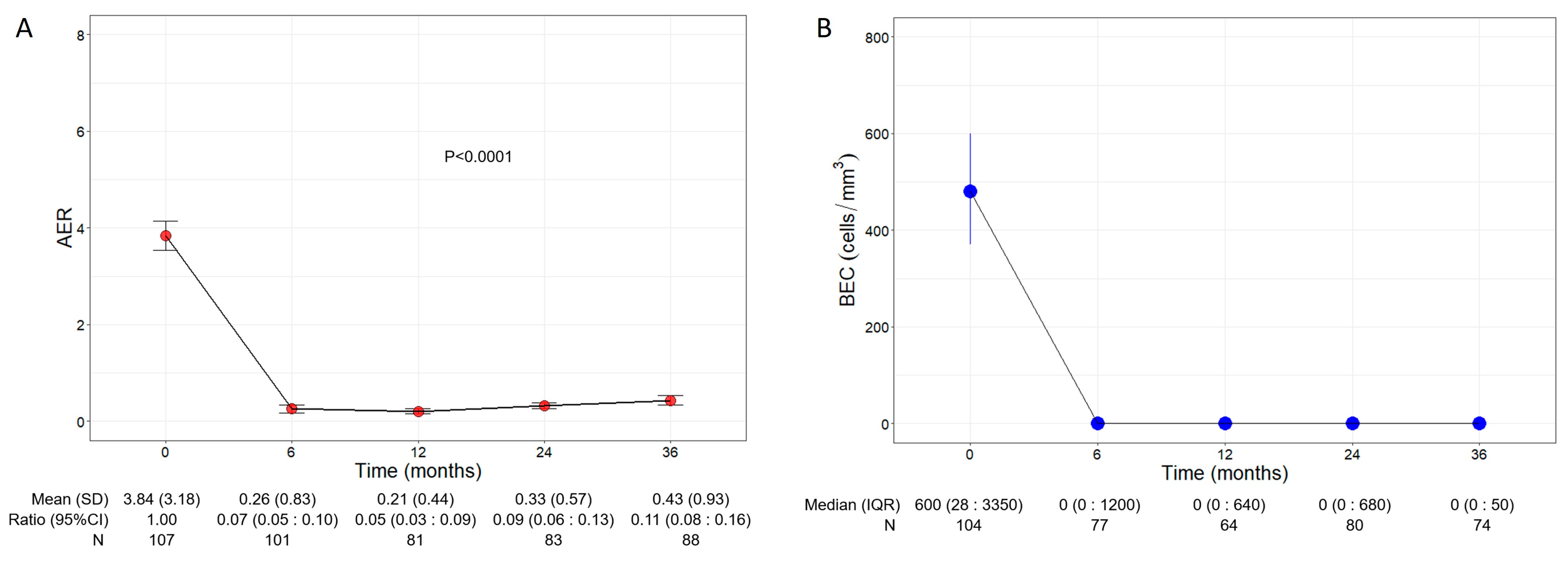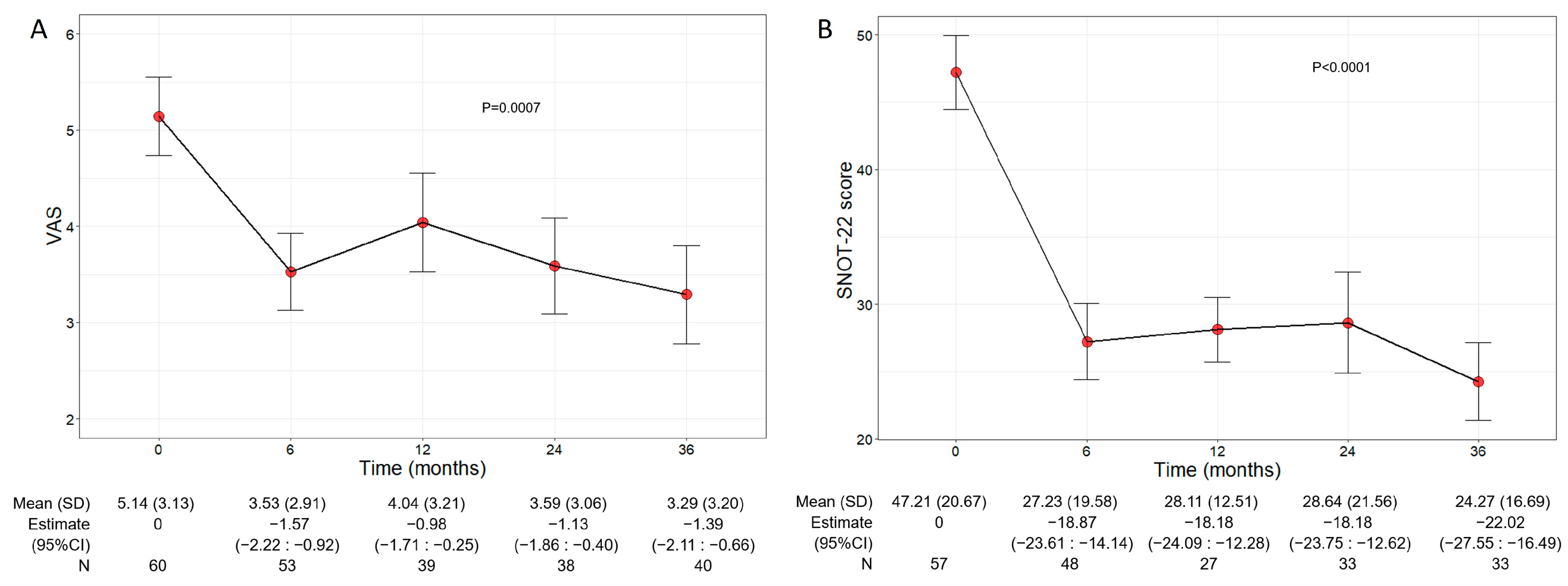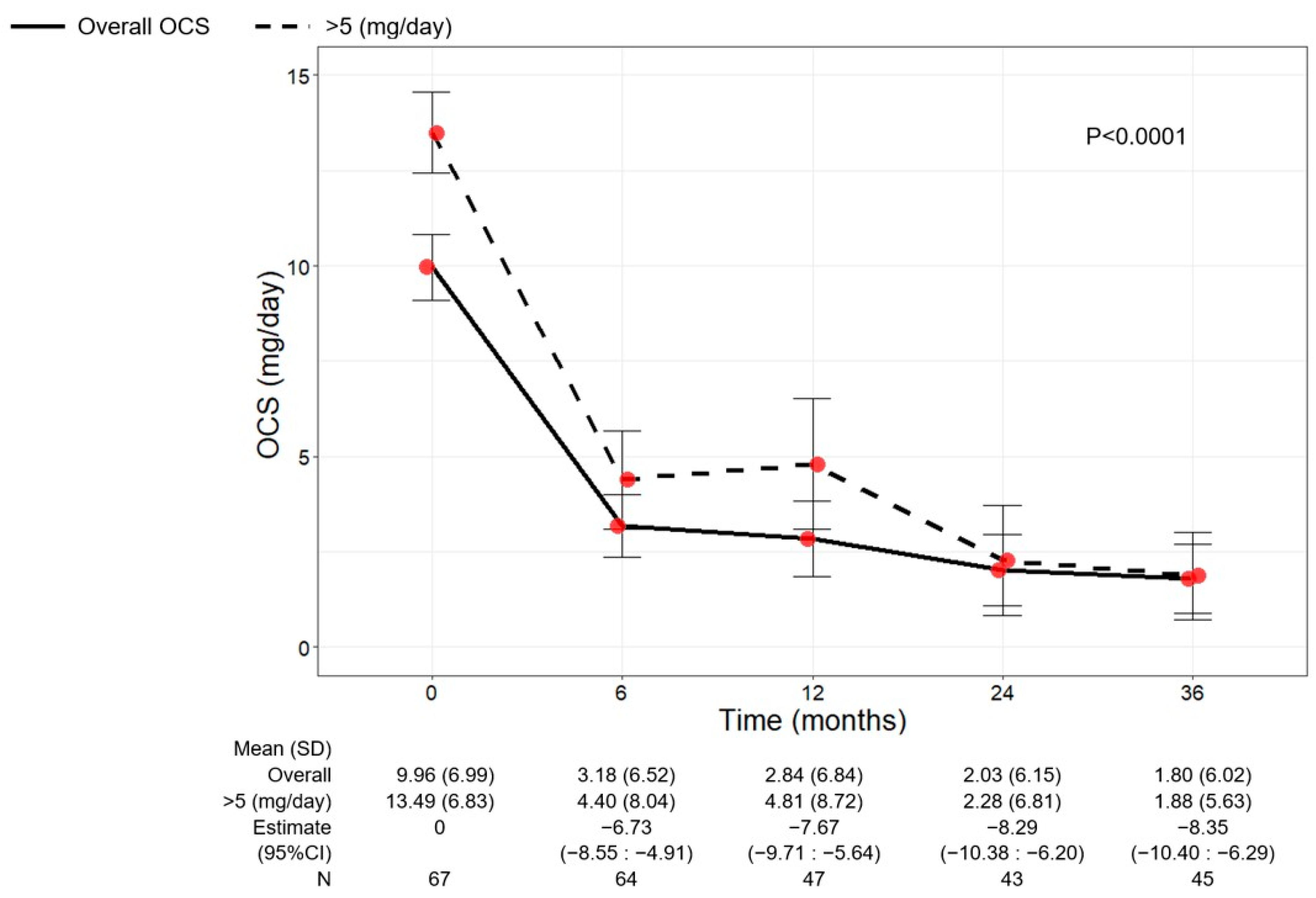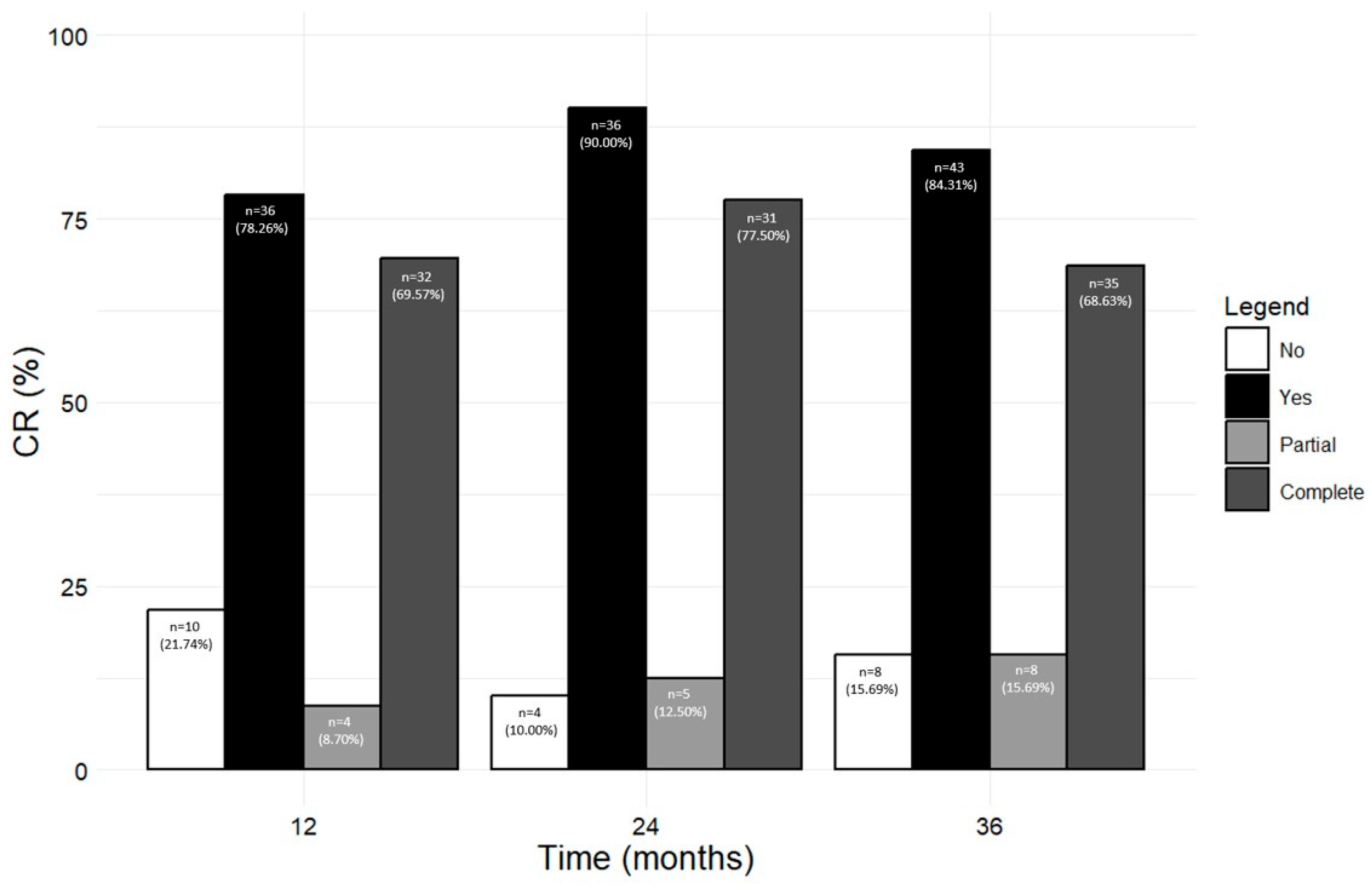Unlocking the Long-Term Effectiveness of Benralizumab in Severe Eosinophilic Asthma: A Three-Year Real-Life Study
Abstract
1. Introduction
2. Materials and Methods
Statistical Analyses
3. Results
3.1. Patients’ Characteristics at Baseline
3.2. Benralizumab Reduced Exacerbations and Inflammatory Markers
3.3. Benralizumab Improved Lung Function
3.4. Benralizumab Increased Asthma Control and QoL
3.5. Benralizumab Alleviated Sinonasal Symptoms in Comorbid Patients
3.6. Benralizumab Decreased the Use of OCS
3.7. Benralizumab Reduced the Need for Asthma Background Medication
3.8. Benralizumab Promoted the Achievement of CR
4. Discussion
5. Conclusions
Supplementary Materials
Author Contributions
Funding
Institutional Review Board Statement
Informed Consent Statement
Data Availability Statement
Acknowledgments
Conflicts of Interest
References
- Chung, K.F.; Wenzel, S.E.; Brozek, J.L.; Bush, A.; Castro, M.; Sterk, P.J.; Adcock, I.M.; Bateman, E.D.; Bel, E.H.; Bleecker, E.R.; et al. International ERS/ATS guidelines on definition, evaluation and treatment of severe asthma. Eur. Respir. J. 2014, 43, 343–373. [Google Scholar] [CrossRef] [PubMed]
- Hekking, P.-P.W.; Wener, R.R.; Amelink, M.; Zwinderman, A.H.; Bouvy, M.L.; Bel, E.H. The prevalence of severe refractory asthma. J. Allergy Clin. Immunol. 2015, 135, 896–902. [Google Scholar] [CrossRef] [PubMed]
- Bagnasco, D.; Paggiaro, P.; Latorre, M.; Folli, C.; Testino, E.; Bassi, A.; Milanese, M.; Heffler, E.; Manfredi, A.; Riccio, A.M.; et al. Severe asthma: One disease and multiple definitions. World Allergy Organ. J. 2021, 14, 100606. [Google Scholar] [CrossRef] [PubMed]
- Buhl, R.; Humbert, M.; Bjermer, L.; Chanez, P.; Heaney, L.G.; Pavord, I.; Quirce, S.; Virchow, J.C.; Holgate, S. Severe eosinophilic asthma: A roadmap to consensus. Eur. Respir. J. 2017, 49, 1700634. [Google Scholar] [CrossRef] [PubMed]
- Perez-de-Llano, L.; Tran, T.N.; Al-ahmad, M.; Alacqua, M.; Bulathsinhala, L.; Busby, J.; Canonica, G.W.; Carter, V.; Chaudhry, I.; Christoff, G.C.; et al. Characterization of Eosinophilic and Non-Eosinophilic Severe Asthma Phenotypes and Proportion of Patients with These Phenotypes in the International Severe Asthma Registry (ISAR). In C21. Advances in Adult and Pediatric Asthma Phenotyping and Endotyping; American Thoracic Society: New York, NY, USA, 2020; p. A4525. [Google Scholar]
- Maio, S.; Baldacci, S.; Bresciani, M.; Simoni, M.; Latorre, M.; Murgia, N.; Spinozzi, F.; Braschi, M.; Antonicelli, L.; Brunetto, B.; et al. RItA: The Italian severe/uncontrolled asthma registry. Allergy 2018, 73, 683–695. [Google Scholar] [CrossRef] [PubMed]
- Bakakos, A.; Loukides, S.; Bakakos, P. Severe Eosinophilic Asthma. J. Clin. Med. 2019, 8, 1375. [Google Scholar] [CrossRef] [PubMed]
- de Groot, J.C.; Ten Brinke, A.; Bel, E.H.D. Management of the patient with eosinophilic asthma: A new era begins. ERJ Open Res. 2015, 1, 00024–02015. [Google Scholar] [CrossRef] [PubMed]
- Heaney, L.G.; Perez de Llano, L.; Al-Ahmad, M.; Backer, V.; Busby, J.; Canonica, G.W.; Christoff, G.C.; Cosio, B.G.; FitzGerald, J.M.; Heffler, E.; et al. Eosinophilic and Noneosinophilic Asthma: An Expert Consensus Framework to Characterize Phenotypes in a Global Real-Life Severe Asthma Cohort. Chest 2021, 160, 814–830. [Google Scholar] [CrossRef]
- Laidlaw, T.M.; Mullol, J.; Woessner, K.M.; Amin, N.; Mannent, L.P. Chronic Rhinosinusitis with Nasal Polyps and Asthma. J. Allergy Clin. Immunol. Pract. 2021, 9, 1133–1141. [Google Scholar] [CrossRef]
- Massoth, L.; Anderson, C.; McKinney, K.A. Asthma and Chronic Rhinosinusitis: Diagnosis and Medical Management. Med. Sci. 2019, 7, 53. [Google Scholar] [CrossRef]
- 2023 Gina Main Report. Available online: https://ginasthma.org/wp-content/uploads/2023/05/GINA-2023-Full-Report-2023-WMS.pdf (accessed on 8 May 2024).
- Price, D.B.; Trudo, F.; Voorham, J.; Xu, X.; Kerkhof, M.; Ling Zhi Jie, J.; Tran, T.N. Adverse outcomes from initiation of systemic corticosteroids for asthma: Long-term observational study. J. Asthma Allergy 2018, 11, 193–204. [Google Scholar] [CrossRef] [PubMed]
- Lee, H.; Ryu, J.; Nam, E.; Chung, S.J.; Yeo, Y.; Park, D.W.; Park, T.S.; Moon, J.-Y.; Kim, T.-H.; Sohn, J.W.; et al. Increased mortality in patients with corticosteroid-dependent asthma: A nationwide population-based study. Eur. Respir. J. 2019, 54, 1900804. [Google Scholar] [CrossRef] [PubMed]
- Bourdin, A.; Molinari, N.; Vachier, I.; Pahus, L.; Suehs, C.; Chanez, P. Mortality: A neglected outcome in OCS-treated severe asthma. Eur. Respir. J. 2017, 50, 1701486. [Google Scholar] [CrossRef] [PubMed]
- Lommatzsch, M.; Brusselle, G.G.; Levy, M.L.; Canonica, G.W.; Pavord, I.D.; Schatz, M.; Virchow, J.C. A2BCD: A concise guide for asthma management. Lancet Respir. Med. 2023, 11, 573–576. [Google Scholar] [CrossRef] [PubMed]
- Chen, W.; Tran, T.N.; Sadatsafavi, M.; Murray, R.; Wong, N.C.B.; Ali, N.; Ariti, C.; Bulathsinhala, L.; Gil, E.G.; FitzGerald, J.M.; et al. Impact of Initiating Biologics in Patients With Severe Asthma on Long-Term Oral Corticosteroids or Frequent Rescue Steroids (GLITTER): Data From the International Severe Asthma Registry. J. Allergy Clin. Immunol. Pract. 2023, 11, 2732–2747. [Google Scholar] [CrossRef] [PubMed]
- Chen, M.; Shepard, K., 2nd; Yang, M.; Raut, P.; Pazwash, H.; Holweg, C.T.J.; Choo, E. Overlap of allergic, eosinophilic and type 2 inflammatory subtypes in moderate-to-severe asthma. Clin. Exp. Allergy J. Br. Soc. Allergy Clin. Immunol. 2021, 51, 546–555. [Google Scholar] [CrossRef]
- Canonica, G.W.; Blasi, F.; Carpagnano, G.E.; Guida, G.; Heffler, E.; Paggiaro, P.; Allegrini, C.; Antonelli, A.; Aruanno, A.; Bacci, E.; et al. Severe Asthma Network Italy Definition of Clinical Remission in Severe Asthma: A Delphi Consensus. J. Allergy Clin. Immunol. Pract. 2023, 11, 3629–3637. [Google Scholar] [CrossRef] [PubMed]
- Lommatzsch, M.; Brusselle, G.G.; Canonica, G.W.; Jackson, D.J.; Nair, P.; Buhl, R.; Virchow, J.C. Disease-modifying anti-asthmatic drugs. Lancet 2022, 399, 1664–1668. [Google Scholar] [CrossRef] [PubMed]
- Available online: https://www.ema.europa.eu/en/documents/product-information/fasenra-epar-product-information_en.pdf (accessed on 8 May 2024).
- Dagher, R.; Kumar, V.; Copenhaver, A.M.; Gallagher, S.; Ghaedi, M.; Boyd, J.; Newbold, P.; Humbles, A.A.; Kolbeck, R. Novel mechanisms of action contributing to benralizumab’s potent anti-eosinophilic activity. Eur. Respir. J. 2022, 59, 2004306. [Google Scholar] [CrossRef]
- Caminati, M.; Bagnasco, D.; Vaia, R.; Senna, G. New horizons for the treatment of severe, eosinophilic asthma: Benralizumab, a novel precision biologic. Biol. Targets Ther. 2019, 13, 89–95. [Google Scholar] [CrossRef]
- Menzella, F.; Biava, M.; Bagnasco, D.; Galeone, C.; Simonazzi, A.; Ruggiero, P.; Facciolongo, N. Efficacy and steroid-sparing effect of benralizumab: Has it an advantage over its competitors? Drugs Context 2019, 8, 212580. [Google Scholar] [CrossRef] [PubMed]
- Vultaggio, A.; Aliani, M.; Altieri, E.; Bracciale, P.; Brussino, L.; Caiaffa, M.F.; Cameli, P.; Canonica, G.W.; Caruso, C.; Centanni, S.; et al. Long-term effectiveness of benralizumab in severe eosinophilic asthma patients treated for 96-weeks: Data from the ANANKE study. Respir. Res. 2023, 24, 135. [Google Scholar] [CrossRef] [PubMed]
- Bergantini, L.; d’Alessandro, M.; Pianigiani, T.; Cekorja, B.; Bargagli, E.; Cameli, P. Benralizumab affects NK cell maturation and proliferation in severe asthmatic patients. Clin. Immunol. 2023, 253, 109680. [Google Scholar] [CrossRef] [PubMed]
- Korn, S.; Bourdin, A.; Chupp, G.; Cosio, B.G.; Arbetter, D.; Shah, M.; Gil, E.G. Integrated Safety and Efficacy Among Patients Receiving Benralizumab for Up to 5 Years. J. Allergy Clin. Immunol. Pract. 2021, 9, 4381–4392.e4. [Google Scholar] [CrossRef] [PubMed]
- Vitale, C.; Maglio, A.; Pelaia, C.; D’Amato, M.; Ciampo, L.; Pelaia, G.; Molino, A.; Vatrella, A. Effectiveness of Benralizumab in OCS-Dependent Severe Asthma: The Impact of 2 Years of Therapy in a Real-Life Setting. J. Clin. Med. 2023, 12, 985. [Google Scholar] [CrossRef] [PubMed]
- Sposato, B.; Scalese, M.; Camiciottoli, G.; Carpagnano, G.E.; Pelaia, C.; Santus, P.; Pelaia, G.; Palmiero, G.; Di Tomassi, M.; Ronchi, M.C.; et al. Severe asthma and long-term Benralizumab effectiveness in real-life. Eur. Rev. Med. Pharmacol. Sci. 2022, 26, 7461–7473. [Google Scholar] [CrossRef] [PubMed]
- Caminati, M.; Marcon, A.; Guarnieri, G.; Miotti, J.; Bagnasco, D.; Carpagnano, G.E.; Pelaia, G.; Vaia, R.; Maule, M.; Vianello, A.; et al. Benralizumab Efficacy in Late Non-Responders to Mepolizumab and Variables Associated with Occurrence of Switching: A Real-Word Perspective. J. Clin. Med. 2023, 12, 1836. [Google Scholar] [CrossRef] [PubMed]
- Fyles, F.; Nuttall, A.; Joplin, H.; Burhan, H. Long-Term Real-World Outcomes of Mepolizumab and Benralizumab Among Biologic-Naive Patients With Severe Eosinophilic Asthma: Experience of 3 Years’ Therapy. J. Allergy Clin. Immunol. Pract. 2023, 11, 2715–2723. [Google Scholar] [CrossRef] [PubMed]
- Risco, M.; Sotomayor, J.; Alvarez-Sala, P.; Piorno, I.; Diaz-Campos, R.; Moya, B.; Crespo, J.F.; Fernandez, C.; GarcÃa Moguel, I. Long-term effectiveness and safety of benralizumab for uncontrolled eosinophilic asthma in real-word practice. J. Allergy Clin. Immunol. 2022, 149, AB16. [Google Scholar] [CrossRef]
- Numata, T.; Araya, J.; Okuda, K.; Miyagawa, H.; Minagawa, S.; Ishikawa, T.; Hara, H.; Kuwano, K. Long-Term Efficacy and Clinical Remission After Benralizumab Treatment in Patients with Severe Eosinophilic Asthma: A Retrospective Study. J. Asthma Allergy 2022, 15, 1731–1741. [Google Scholar] [CrossRef]
- Jackson, D.J.; Heaney, L.G.; Humbert, M.; Kent, B.D.; Shavit, A.; Hiljemark, L.; Olinger, L.; Cohen, D.; Menzies-Gow, A.; Korn, S.; et al. Reduction of daily maintenance inhaled corticosteroids in patients with severe eosinophilic asthma treated with benralizumab (SHAMAL): A randomised, multicentre, open-label, phase 4 study. Lancet 2024, 403, 271–281. [Google Scholar] [CrossRef] [PubMed]
- Piano Terapeutico AIFA per la Prescrizione SSN di Fasenra (Benralizumab) Nell’asma Grave Eosinofilico Refrattario [Internet]. Gazzetta Ufficiale della Repubblica Italiana. Available online: https://www.gazzettaufficiale.it/atto/serie_generale/caricaDettaglioAtto/originario?atto.dataPubblicazioneGazzetta=2019-02-12&atto.codiceRedazionale=19A00829&elenco30giorni=false (accessed on 8 May 2024).
- Gelman, A.; Hill, J. Data Analysis Using Regression and Multilevel/Hierarchical Models; Cambridge University Press: Cambridge, UK; New York, NY, USA, 2007. [Google Scholar]
- Available online: https://www.r-project.org/ (accessed on 8 May 2024).
- Toma, S.; Hopkins, C. Stratification of SNOT-22 scores into mild, moderate or severe and relationship with other subjective instruments. Rhinol. J. 2016, 54, 129–133. [Google Scholar] [CrossRef] [PubMed]
- Wechsler, M.E.; Nair, P.; Terrier, B.; Walz, B.; Bourdin, A.; Jayne, D.R.W.; Jackson, D.J.; Roufosse, F.; Börjesson Sjö, L.; Fan, Y.; et al. Benralizumab versus Mepolizumab for Eosinophilic Granulomatosis with Polyangiitis. N. Engl. J. Med. 2024, 390, 911–921. [Google Scholar] [CrossRef] [PubMed]
- FitzGerald, J.M.; Bleecker, E.R.; Bourdin, A.; Busse, W.W.; Ferguson, G.T.; Brooks, L.; Barker, P.; Martin, U.J. Two-Year Integrated Efficacy And Safety Analysis Of Benralizumab In Severe Asthma. J. Asthma Allergy 2019, 12, 401–413. [Google Scholar] [CrossRef] [PubMed]
- McIntosh, M.J.; Kooner, H.K.; Eddy, R.L.; Wilson, A.; Serajeddini, H.; Bhalla, A.; Licskai, C.; Mackenzie, C.A.; Yamashita, C.; Parraga, G. CT Mucus Score and 129Xe MRI Ventilation Defects after 2.5 Years’ Anti-IL-5Rα in Eosinophilic Asthma. CHEST 2023, 164, 27–38. [Google Scholar] [CrossRef] [PubMed]
- Nolasco, S.; Crimi, C.; Pelaia, C.; Benfante, A.; Caiaffa, M.F.; Calabrese, C.; Carpagnano, G.E.; Ciotta, D.; D’Amato, M.; Macchia, L.; et al. Benralizumab Effectiveness in Severe Eosinophilic Asthma with and without Chronic Rhinosinusitis with Nasal Polyps: A Real-World Multicenter Study. J. Allergy Clin. Immunol. Pract. 2021, 9, 4371–4380.e4. [Google Scholar] [CrossRef] [PubMed]
- Lombardo, N.; Pelaia, C.; Ciriolo, M.; Della Corte, M.; Piazzetta, G.; Lobello, N.; Viola, P.; Pelaia, G. Real-life effects of benralizumab on allergic chronic rhinosinusitis and nasal polyposis associated with severe asthma. Int. J. Immunopathol. Pharmacol. 2020, 34, 205873842095085. [Google Scholar] [CrossRef] [PubMed]
- Bagnasco, D.; Brussino, L.; Bonavia, M.; Calzolari, E.; Caminati, M.; Caruso, C.; D’Amato, M.; De Ferrari, L.; Di Marco, F.; Imeri, G.; et al. Efficacy of Benralizumab in severe asthma in real life and focus on nasal polyposis. Respir. Med. 2020, 171, 106080. [Google Scholar] [CrossRef] [PubMed]
- Santomasi, C.; Buonamico, E.; Dragonieri, S.; Iannuzzi, L.; Portacci, A.; Quaranta, N.; Carpagnano, G.E. Effects of benralizumab in a population of patients affected by severe eosinophilic asthma and chronic rhinosinusitis with nasal polyps: A real life study. Acta Biomed. Atenei Parm. 2023, 94, e2023028. [Google Scholar] [CrossRef]
- Kanda, A.; Kobayashi, Y.; Asako, M.; Tomoda, K.; Kawauchi, H.; Iwai, H. Regulation of Interaction between the Upper and Lower Airways in United Airway Disease. Med. Sci. 2019, 7, 27. [Google Scholar] [CrossRef]
- Menzies-Gow, A.; Gurnell, M.; Heaney, L.G.; Corren, J.; Bel, E.H.; Maspero, J.; Harrison, T.; Jackson, D.J.; Price, D.; Lugogo, N.; et al. Oral corticosteroid elimination via a personalised reduction algorithm in adults with severe, eosinophilic asthma treated with benralizumab (PONENTE): A multicentre, open-label, single-arm study. Lancet Respir. Med. 2022, 10, 47–58. [Google Scholar] [CrossRef] [PubMed]
- Caminati, M.; Vianello, A.; Andretta, M.; Menti, A.M.; Tognella, S.; Esposti, L.D.; Gianenrico, S. Astonishing low adherence to inhaled therapy characterizes patients with severe asthma treated with biologics. World Allergy Organ. J. 2020, 13, 100377. [Google Scholar] [CrossRef]
- Menzies-Gow, A.; Hoyte, F.L.; Price, D.B.; Cohen, D.; Barker, P.; Kreindler, J.; Jison, M.; Brooks, C.L.; Papeleu, P.; Katial, R. Clinical Remission in Severe Asthma: A Pooled Post Hoc Analysis of the Patient Journey with Benralizumab. Adv. Ther. 2022, 39, 2065–2084. [Google Scholar] [CrossRef] [PubMed]
- Jackson, D.; Pelaia, G.; Padilla-Galo, A.; Watt, M.; Kayaniyil, S.; Boarino, S.; Tena, J.S.; Shih, V.; Tran, T.; Arbetter, D.; et al. Asthma Clinical Remission with Benralizumab in an Integrated Analysis of the Real-World XALOC-1 Study. J. Allergy Clin. Immunol. 2023, 151, AB13. [Google Scholar] [CrossRef]
- Campisi, R.; Nolasco, S.; Pelaia, C.; Impellizzeri, P.; D’Amato, M.; Portacci, A.; Ricciardi, L.; Scioscia, G.; Crimi, N.; Scichilone, N.; et al. Benralizumab Effectiveness in Severe Eosinophilic Asthma with Co-Presence of Bronchiectasis: A Real-World Multicentre Observational Study. J. Clin. Med. 2023, 12, 3953. [Google Scholar] [CrossRef] [PubMed]
- Hirano, T.; Matsunaga, K. Late-onset asthma: Current perspectives. J. Asthma Allergy 2018, 11, 19–27. [Google Scholar] [CrossRef] [PubMed]
- Oishi, K.; Hamada, K.; Murata, Y.; Yamaji, Y.; Asami, M.; Edakuni, N.; Hirano, T.; Matsunaga, K. Achievement rate and predictive factors of the deep remission to biologics in severe asthma. Eur. Respir. J. 2022, 60, 4401. [Google Scholar] [CrossRef]
- Oishi, K.; Hamada, K.; Murata, Y.; Matsuda, K.; Ohata, S.; Yamaji, Y.; Asami-Noyama, M.; Edakuni, N.; Kakugawa, T.; Hirano, T.; et al. A Real-World Study of Achievement Rate and Predictive Factors of Clinical and Deep Remission to Biologics in Patients with Severe Asthma. J. Clin. Med. 2023, 12, 2900. [Google Scholar] [CrossRef]
- Talari, K.; Goyal, M. Retrospective Studies–Utility and Caveats. J. R. Coll. Physicians Edinb. 2020, 50, 398–402. [Google Scholar] [CrossRef]






| Characteristics at Baseline | Patient Population |
|---|---|
| Age (years) | 55.96 (11.38) |
| Sex (female) | 64 (59.26%) |
| BMI (kg/m2) | |
| Underweight/normal weight | 46 (42.59%) |
| Overweight | 46 (42.59%) |
| Obese | 16 (14.81%) |
| Smoking status | |
| Non-smokers | 78 (72.22%) |
| Previous smokers | 29 (26.85%) |
| Current smokers | 1 (0.93%) |
| Comorbidities | 94 (87.04%) |
| CRS | 67 (62.62%) |
| CRSwNP | 65 (60.19%) |
| Allergic rhinitis | 57 (52.78%) |
| Gastroesophageal reflux disease (GERD) | 39 (36.11%) |
| Bronchiectasis (n = 104) | 28 (26.96%) |
| EGPA (n = 96) | 4 (4.71%) |
| Eosinophilic esophagitis (n = 93) | 1 (1.08%) |
| Age at asthma diagnosis (years) (n = 106) | 35.68 (15.95) |
| ICS dose (mcg/day) (n = 87) | 1006.93 (402.56) |
| <500 | 8 (9.20%) |
| ≥500 and <1000 | 44 (50.57%) |
| ≥1000 | 35 (40.23%) |
| LAMA (n = 107) | 79 (73.83%) |
| Anti LT (n = 107) | 52 (48.60%) |
| Theophylline (n = 106) | 6 (5.66%) |
| SABA and/or ICS/LABA as needed (times per day) (n = 88) | 3.10 (4.19) |
| OCS | 67 (62.04%) |
| OCS dose (prednisone equivalent) (mg/day) (n = 67) | 7.95 (7.42) |
| ≤5 mg/day | 26 (38.81%) |
| >5 mg/day | 41 (61.19%) |
| Biologic switch (n = 98) | |
| Naïve | 89 (82.41%) |
| Switched | 19 (17.59%) |
| BEC (cells/mm3) (n = 104) | 600 (28–3350) |
| FeNO (ppb) (N = 55) | 61.95 (55.66) |
| Total serum IgE (IU/mL) (n = 91) | 209 (4.9–1940) |
| AER (n = 107) | 3.84 (3.18) |
| Exacerbation phenotype (n = 45) | |
| Bacterial | 24 (53.33%) |
| Viral | 7 (15.56%) |
| Non-infectious | 14 (31.11%) |
| Lung function | |
| FEV1 (L/min) (n = 101) | 1.94 (0.83) |
| FVC (L) (n = 90) | 3.30 (1.00) |
| FEV1 (% pred.) (n = 86) | 74.50 (20.68) |
| FVC (% pred.) (n = 91) | 93.97 (20.73) |
| FEV1/FVC (n = 91) | 54.11 (24.87) |
| Asthma PROs | |
| ACT score (n = 104) | 14.41 (5.08) |
| ACQ score (n = 39) | 2.33 (1.25) |
| AQLQ score (n = 31) | 3.76 (1.45) |
| CRSwNP PROs | |
| VAS (n = 60) | 5.14 (3.13) |
| SNOT-22 score (n = 57) | 47.21 (20.67) |
| Extent of OCS Reduction | Month 6 (n = 64) | Month 12 (n = 47) | Month 24 (n = 43) | Month 36 (n = 45) |
|---|---|---|---|---|
| Any reduction | 52 (81.25%) | 41 (87.23%) | 39 (90.7%) | 42 (93.33%) |
| ≥90% | 39 (60.94%) | 34 (72.34%) | 34 (79.07%) | 38 (84.44%) |
| ≥75% | 42 (65.62%) | 38 (80.85%) | 37 (86.05%) | 39 (86.67%) |
| ≥50% | 50 (78.12%) | 41 (87.23%) | 38 (88.37%) | 42 (93.33%) |
| ≥25% | 51 (79.69%) | 41 (87.23%) | 39 (90.7%) | 42 (93.33%) |
| No reduction | 12 (18.75%) | 6 (12.77%) | 4 (9.3%) | 3 (6.67%) |
| Elimination | 39 (60.94%) | 34 (72.34%) | 33 (76.74%) | 38 (84.44%) |
| Parameter | Baseline | Month 6 | Month 12 | Month 24 | Month 36 | p-Value |
|---|---|---|---|---|---|---|
| ICS dose (mcg/day) | 1006.93 (402.56) n = 87 | 895.09 (420.65) n = 85 | 853.93 (408.02) n = 68 | 841.47 (411.64) n = 70 | 800.04 (394.89) n = 70 | |
| ICS dose (mcg/day) | 1006.93 (402.56) | 895.09 (420.65) | 853.93 (408.02) | 841.47 (411.64) | 800.04 (394.89) | 0.0010 † |
| <500 | 8 (9.20%) | 17 (20.00%) | 19 (27.94%) | 21 (30.00%) | 23 (32.86%) | |
| ≥500 and <1000 | 44 (50.57%) | 43 (50.59%) | 32 (47.06%) | 32 (45.71%) | 31 (44.29%) | |
| ≥1000 | 35 (40.23%) | 25 (29.41%) | 17 (25.00%) | 17 (24.29%) | 16 (22.86%) | |
| * | 1 | 0.37 (0.12:1.13) | 0.22 (0.07:0.71) | 0.17 (0.06:0.55) | 0.11 (0.02:0.68) | |
| # | 1 | 0.13 (0.02:0.77) | 0.10 (0.02:0.57) | 0.09 (0.01:0.54) | 0.15 (0.05:0.47) | |
| SABA or ICS-LABA as needed (times per day) | 3.10 (4.19) | 0.35 (0.96) | 0.2 (0.6) | 0.43 (1.42) | 0.38 (1.85) | <0.0001 |
| 0 | −2.72 (−3.37:−2.07) | −2.78 (−3.51:−2.06) | −2.59 (−3.3:−1.89) | −2.73 (−3.43:−2.04) | ||
| n = 88 | n = 85 | n = 61 | n = 67 | n = 71 | ||
| LAMA | 0.0008 | |||||
| No | 28 (26.17%) | 29 (28.16%) | 28 (29.17%) | 34 (40%) | 38 (44.19%) | |
| Yes | 79 (73.83%) | 74 (71.84%) | 68 (70.83%) | 51 (60%) | 48 (55.81%) | |
| 1 | 0.50 (0.13:1.85) | 0.29 (0.07:1.12) | 0.13 (0.03:0.53) | 0.04 (0.01:0.20) | ||
| n = 107 | n = 103 | n = 96 | n = 85 | n = 86 | ||
| Anti LT | <0.0001 | |||||
| No | 55 (51.40%) | 56 (54.9%) | 55 (57.89%) | 57 (67.06%) | 59 (68.6%) | |
| Yes | 52 (48.60%) | 46 (45.10%) | 40 (42.11%) | 28 (32.94%) | 27 (31.4%) | |
| 1 | 0.48 (0.16:1.40) | 0.22 (0.07:0.70) | 0.06 (0.02:0.23) | 0.06 (0.02:0.23) | ||
| n = 107 | n = 102 | n = 95 | n = 85 | n = 86 | ||
| Theophylline | 0.0070 | |||||
| No | 100 (94.34%) | 100 (99.01%) | 95 (98.96%) | 82 (96.47%) | 84 (100%) | |
| Yes | 6 (5.66%) | 1 (0.99%) | 1 (1.04%) | 3 (3.53%) | 0 (0%) | |
| 1 | 0.01 (0:0.68) | 0.01 (0:0.38) | 0.08 (0.01:1.14) | 0 (0:Inf) | ||
| n = 106 | n = 101 | n = 96 | n = 85 | n = 84 |
Disclaimer/Publisher’s Note: The statements, opinions and data contained in all publications are solely those of the individual author(s) and contributor(s) and not of MDPI and/or the editor(s). MDPI and/or the editor(s) disclaim responsibility for any injury to people or property resulting from any ideas, methods, instructions or products referred to in the content. |
© 2024 by the authors. Licensee MDPI, Basel, Switzerland. This article is an open access article distributed under the terms and conditions of the Creative Commons Attribution (CC BY) license (https://creativecommons.org/licenses/by/4.0/).
Share and Cite
Pini, L.; Bagnasco, D.; Beghè, B.; Braido, F.; Cameli, P.; Caminati, M.; Caruso, C.; Crimi, C.; Guarnieri, G.; Latorre, M.; et al. Unlocking the Long-Term Effectiveness of Benralizumab in Severe Eosinophilic Asthma: A Three-Year Real-Life Study. J. Clin. Med. 2024, 13, 3013. https://doi.org/10.3390/jcm13103013
Pini L, Bagnasco D, Beghè B, Braido F, Cameli P, Caminati M, Caruso C, Crimi C, Guarnieri G, Latorre M, et al. Unlocking the Long-Term Effectiveness of Benralizumab in Severe Eosinophilic Asthma: A Three-Year Real-Life Study. Journal of Clinical Medicine. 2024; 13(10):3013. https://doi.org/10.3390/jcm13103013
Chicago/Turabian StylePini, Laura, Diego Bagnasco, Bianca Beghè, Fulvio Braido, Paolo Cameli, Marco Caminati, Cristiano Caruso, Claudia Crimi, Gabriella Guarnieri, Manuela Latorre, and et al. 2024. "Unlocking the Long-Term Effectiveness of Benralizumab in Severe Eosinophilic Asthma: A Three-Year Real-Life Study" Journal of Clinical Medicine 13, no. 10: 3013. https://doi.org/10.3390/jcm13103013
APA StylePini, L., Bagnasco, D., Beghè, B., Braido, F., Cameli, P., Caminati, M., Caruso, C., Crimi, C., Guarnieri, G., Latorre, M., Menzella, F., Micheletto, C., Vianello, A., Visca, D., Bondi, B., El Masri, Y., Giordani, J., Mastrototaro, A., Maule, M., ... on behalf of the SANI Study Group. (2024). Unlocking the Long-Term Effectiveness of Benralizumab in Severe Eosinophilic Asthma: A Three-Year Real-Life Study. Journal of Clinical Medicine, 13(10), 3013. https://doi.org/10.3390/jcm13103013















